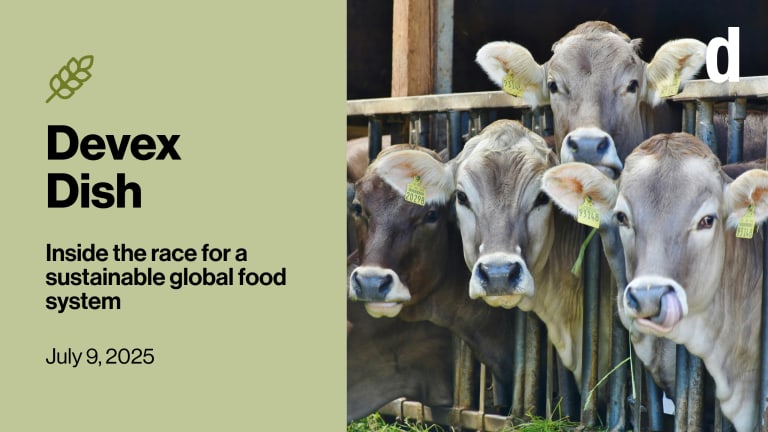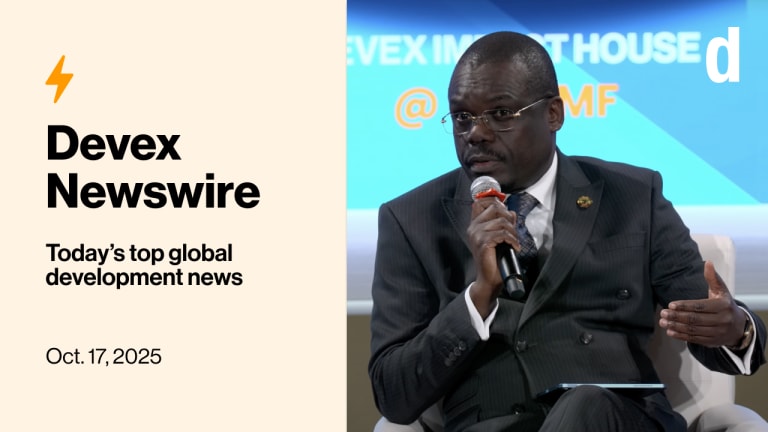
No one exactly knows when the drought and famine in the Horn of Somalia will end. What is “almost sure,” according to Jean-Alexandre Scaglia, is that life for the people in the region will remain difficult in the next six months.
Scaglia serves as senior operations officer in the U.N. Food and Agriculture Organization’s emergency operations and rehabilitation division. The agency is doing what it can to mitigate the crisis, he says. Its focus: saving animals.
“We are really there to try to help the population, to try to save animals; it’s something we did in the past,” he told Devex. “Our objective is, right now, to make sure that [the] maximum number of animals can survive: organizing destocking, preparing for restocking of animals.”
That means buying livestock and cattle from nomadic or transhumant pastoralists at a fair price that allows these locals to buy new animals after the drought.
FAO also works closely with the World Food Program to respond to the emergency. The two lead the so-called global Food Security Cluster, an international task force that aims to strengthen food security responses in humanitarian crisis situations. GFSC is relatively new – in fact, only a few months old.
>> WFP, FAO Unveil New Food Security Response Coordination Platform
Scaglia spoke with Devex last month about the ongoing crisis in the Horn of Africa and the importance of strong partnerships and trade to ensure food security.
In October, short rains are expected. But according to your forecasts, the situation could remain critical until the end of the year or the beginning of 2012. Are we prepared?
We know what to do. There is a need for food aid. No doubt that there is a need for direct assistance. But there is also a huge need to save animals, to do our best to save the maximum number of animals we can: vaccination campaigns, feeding programs for animals, start organizing the restocking of animals. All these kinds of things are possible.
FAO is seeking input on an updated global strategic framework on food security and nutrition. How will the Horn of Africa benefit from it?
We say “global” because we have to put the Horn of Africa in its regional context. It’s a [known] problem. If you read the 2000 document, it was already mentioned [at] that time that one of the key issues is to have a better trade around animals, a problem which is very important for the pastoralists of Horn of Africa. Animals are usually sold in the Arabian peninsula; there is a huge trade which is not enough organized. That’s why we think it’s [a] global issue. Who is buying skins from animals? We know that skins are bought by Europe and different countries.
The Horn of Africa is not isolated by the rest of the world, and part of the solution of the Horn of Africa, and for the population, is to get better benefit of the trade.
What could that look like?
We see already strong professional organizations emerging, with people of the different regions. For example, you see that – very interesting – with the Masai population in Kenya. It is very new, and it is very good. They are really trying to organize themselves, trying to control the trade, not to be passive in the trade, but to be proactive. [They would say:] “We have animals, we have to sell animals.” In the past, they were completely passive, they were expecting that somebody will come and buy the animals. It’s no more the case. The Masai are really organizing themselves in strong professional organizations. It is very good.
Do we need a new global food emergency response architecture?
I don’t know what is the position of the FAO on this. I don’t think it is really necessary at this stage, personally. You have always to integrate. You have so many different contexts all around the world.
What is the role of FAO in aid delivery? And what are the major challenges?
We are already on the ground. We are working with local partners. Logistics is an issue for food aid because you have [a] big volume [of aid]. For FAO, [that] is not exactly the case because when you have to do vaccination campaigns for animals, what you have to carry is a box like that – it is not so big.
We may join forces with WFP when we try to organize feeding programs for animals because this is just like food aid for animals. And with this, yes, you have big volumes to be carried, and sometimes, it’s an issue, especially in a vast regions – the distances can be extremely huge and sometime the roads even don’t really exist.
How do you organize it?
Yes, usually, to be honest, we strongly rely on WFP and some big NGOs. Some big NGOs or international NGOs have very good food aid logistics already in place, and we rely on them to help us with the logistics.
How do you select NGOs?
It can be a call for proposal, saying that we need a partner in this area. If you are, please submit a proposal. We select, it’s a kind of panel. In some areas, we are working already for years with some NGOs. We have already good relationships, and in this case, we even don’t think about that. We know that the right partner is this specific NGO, and we sign directly an agreement with them.
So, everything is possible. We have partnerships with international NGOs, but we also try to develop partnerships with local NGOs. We have both partners in many areas, especially in this part of Africa.
How do you assess whether the local groups you work with have the capacity to deliver?
We try to assess [their capacity]. … There is a system: We never pay [them] immediately. Especially the first time you work with the local NGOs, at [the] end, there is always a kind of automatic assessment which is done. The main question is: Did they deliver? They have to submit [a] financial report. They have to submit reports just to try to understand what has been done.
Is there a danger that once the dust settles, we’ll be hearing allegations of fraud, waste and abuse of aid money?
Of course, there is. But to be honest, it is not so common. You always find a case somewhere, but it is not so common.
Somalia’s Transitional Federal Government announced plans to create a committee to coordinate aid distribution and craft new accountability measures for aid organizations in the region. What’s your take on this? Can aid groups influence this process now? Will you cooperate?
We are trying to cooperate. That’s all we can say. Somalia is so difficult. We’ve tried in the past with the different governments of Somalia. Some lasted a day, some lasted months. It is very difficult.
Was the crisis preventable? Was it man-made? Who’s to blame? Read Jean-Alexandre Scaglia’s answers to some of the questions that have dominated the public discourse over the past few weeks.
Read more:








